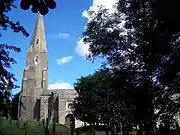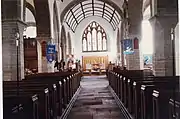Modbury
Modbury is a large village, ecclesiastical parish, civil parish and former manor situated in the South Hams district of the county of Devon in England. Today due to its large size it is generally referred to as a "town" although the parish council has not elected to give itself the status of a town as it could do under s.245(6) of the Local Government Act 1972,[2] so it does not have a town council and cannot have a town mayor. It is also known informally as a "market town", as from at least 1199 the lord of the manor has held the right to hold a regular market.[3] The village is situated on the A379 road, which links it to Plymouth and Kingsbridge. The current parish population is approximately 1,500.
| Modbury | |
|---|---|
 Church Street, Modbury | |
 Modbury Location within Devon | |
| Population | 1,454 (2001)[1] |
| OS grid reference | SX63835946 |
| • London | 181 mi (291 km) |
| Civil parish |
|
| District | |
| Shire county | |
| Region | |
| Country | England |
| Sovereign state | United Kingdom |
| Post town | IVYBRIDGE |
| Postcode district | PL21 |
| Dialling code | 01548 |
| Police | Devon and Cornwall |
| Fire | Devon and Somerset |
| Ambulance | South Western |
| UK Parliament | |
| Website | Modbury Parish Council website |
Etymology
The name Modbury is a corruption of the Anglo-Saxon name, Moot burgh from 'Moot' meaning either 'Mud' or 'meeting' and 'bury' meaning 'fortified enclosure'.
History
Modbury is recorded in the Domesday Book of 1086.[4] It has had permission to hold a weekly fair since before 1199.[3] The population of the town was greatly reduced as a consequence of the Black Death in the 14th century.
Civil war
Modbury was the site of two battles in the English Civil War. The first battle was a surprise attack by a mounted Parliamentarian force led by Sir William Ruthven that moved under cover of darkness from Plymouth via Ivybridge on 7 December 1642. In the early morning charge they routed a mostly untrained Royalist force that had gathered in the town, where Sir Ralph Hopton, the King's senior commander in the West Country, was holding council at the manor house of Champernowne Court. The house was badly damaged by fire, Hopton escaped but many notable Devon Royalists were captured.
The second Battle of Modbury occurred on 22 February 1643 when the Royalists forces, expecting an attack by Parliamentarian forces assembled at nearby Kingsbridge, had fortified the town. Outnumbered approximately four to one, and running short of ammunition, the royalists retreated. This victory was largely instrumental in the lifting of the Siege of Plymouth, and the driving of the encircling Royalist forces into Cornwall.
19th century
By 1801, the population of Modbury had risen to 1,813, with almost half engaged in the wool trade. The impact of the mechanisation of the wool industry was to have a dramatic effect on the economic prosperity and population of the town in the mid-1820s and later. Many workers left the town and headed to large cities in search of employment; others left the country altogether, emigrating to America.
The railway line bypassed Modbury, contributing still further to this decline. Modbury remained an important market town until as late as 1944 when the cattle market ceased.
Manor
The manor of Modbury was held from the time of the Domesday Book of 1086 by the Vautort family, and passed successively to the families of Okeston and Champernowne. In the Domesday Book is listed as two separate parts;[5][6] the principal one as Motbilie, one of the holdings of Robert, Count of Mortain,[7] half-brother of William the Conqueror. Robert's tenant was one of his important Anglo-Norman followers, Reginald I de Vautort.[8][9] Later, Sir Roger de Vautort granted the manor, together with Bridford, to Sir Alexander de Okeston, of Okeston (alias Oxton), Devon,[10] the second husband of Joan de Vautort, widow of Ralph de Vautort, Sir Roger's elder brother.[11] Joan de Vautort was the mistress of Richard, 1st Earl of Cornwall (1209–1272), second son of King John. By Okeston she had a son Sir James Okeston, who before he died childless named as his heir the son of his half-sister Joan, daughter of Earl Richard and wife of Richard Champernowne of Clyst Champernowne, near Exeter, Devon.[12] The Champernown family was thenceforth seated at Modbury. Sir James Okeston (son of Sir Alexander de Okeston) granted Bridford to Richard Champernowne, as evidenced in a deed dated 1314[13]
The manor house, last occupied by the Champernowne family and known as "Court House", was situated on the north side of the parish church of St George, on or near the site of Modbury Priory, founded in the 12th century by the Vautort lords of the manor. It was destroyed during the Civil War (1642–1651) and the remnants were sold for building materials in 1705.[14]
Church
The parish Church of St George is Grade 1 listed.The main body of the church is fourteenth century and is constructed of coursed rubble with granite dressings beneath slate roofs. The tower has angle buttresses and a broach spire believed to have been struck by lightning in AD 1621 and rebuilt as a copy of the original. The nave has a wagon roof, as do the aisles and transepts, the Lady Chapel, the Vestry, and the chancel. Dendrochronological analysis suggest the church was reroofed in the sixteenth century.[15] The church was placed on Historic England's Heritage at Risk Register in 2013 with concerns about roof damage and damp. A 2015 Heritage Lottery Fund grant led to a extensive programme of roof repairs and restoration.[15]


Historic estates
Wympston
Whympston in the parish of Modbury is a historic manor. In the 12th century it became the earliest English seat of the prominent Norman family of Fortescue, influential in British and West Country history, which survives today as Earl Fortescue, seated in Gloucestershire, but until recently seated at Castle Hill in Devon.
Plastic bag ban
In April 2007 local traders declared that for environmental reasons, they would no longer give customers plastic bags.[17][18][19] This initiative led to other communities, such as Ilam in Staffordshire and Hebden Bridge in West Yorkshire, pursuing similar enterprises.[20]
Modbury Rovers F.C.
Modbury has a recreation field with a football pitch, tennis courts and a tarmac all-weather surface used mainly for skateboarding. This is the home of Modbury Rovers, who are managed by Alex Pitcher and compete in the Plymouth and West Devon Combination League.
Notable former residents
- Katherine 'Kat' Ashley née Champernowne (? – 1565) governess to Elizabeth I was probably born in or near the village.
- Sir George Baker, 1st Baronet, FRS, FSA (1 January 1722 – 15 June 1809), physician to King George III, was born in the town.
- William Battie (sometimes spelt Batty), president of the Royal College of Physicians in 1764 was born in the town.
See also
Notes
References
- "Parish Headcounts". The Office for National Statistics. 1 April 2001. Retrieved 26 October 2010.
- http://www.legislation.gov.uk/ukpga/1972/70/section/245
- "Devon – Modbury". Gazetteer of Markets and Fairs to 1516. history.ac.uk. Retrieved 4 January 2017.
- Open Domesday Online: Modbury, accessed December 2017.
- Open Domesday: Modbury, accessed April 2020.
- Thorn, 15:49 & 15:64
- Thorn, Caroline & Frank, (eds.) Domesday Book, (Morris, John, gen.ed.) Vol. 9, Devon, Parts 1 & 2, Phillimore Press, Chichester, 1985, Part 2 (Notes), 15:64
- Bearman, Robert, biography of Vautort family, Oxford Dictionary of National Biography, Vol.56, 2004, p.214
- Thorn, Caroline & Frank, (eds.) Domesday Book, (Morris, John, gen.ed.) Vol. 9, Devon, Parts 1 & 2, Phillimore Press, Chichester, 1985, 15:64
- "Oxton manor house on the road between Chudleigh and Exeter", per Hamilton, Dom. Adam, OSB, History of St Mary's Abbey of Buckfast, 1906, p.92 . This is Oxton in the parish of Kenton; see Pole, p.257, who mentions an Alexander de Oxton, but makes no mention of a connection with Vautort
- Pole, Sir William (d.1635), Collections Towards a Description of the County of Devon, Sir John-William de la Pole (ed.), London, 1791, pp.248, 309
- Risdon, p.129
- Risdon, p.129: regnal year 8 Edwardus filius Edwardi (ie "Edward son of Edward", thus King Edward II
- Pevsner, Nikolaus & Cherry, Bridget, The Buildings of England: Devon, London, 2004, p.571
- Arnold, A J; Howard, R E; Tyers, C (2017). "Church of St George, Church Lane, Modbury, Devon: Tree-Ring Analysis of Oak Timbers. Historic England Research Report 70/2017". research.historicengland.org.uk. Retrieved 11 June 2020.
- http://www.historyofparliamentonline.org/volume/1386-1421/member/prideaux-sir-john-1347-1403
- Vidal, John (28 April 2007). "Welcome to Modbury. Just don't ask for a plastic bag". The Guardian. Retrieved 15 August 2011.
- Elliott, Valerie (28 April 2007). "Modbury (pop 1,553) is first to ban plastic bags". The Times. Retrieved 15 August 2011.
- Barkham, Patrick (12 May 2007). "World asks town that banned the plastic bag: how can we do it too?". The Guardian. Retrieved 15 August 2011.
- Sunday Telegraph 22 July 2007 2, 406 pC12
External links
- Visit Modbury – Shops and Businesses
- Modbury Heritage
- Modbury Information
- Modbury News
- Aerial photo of Modbury in 1930, part of a series